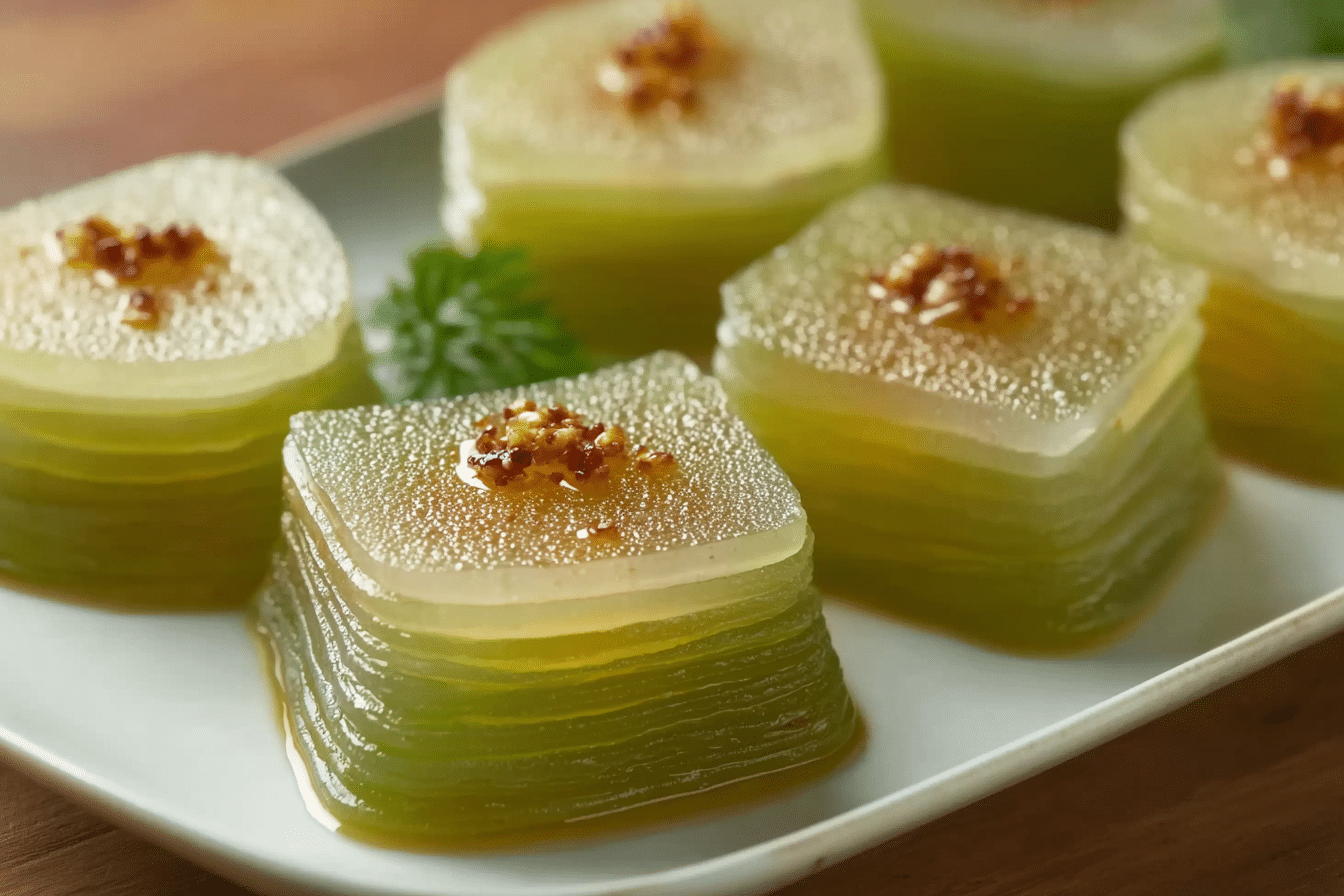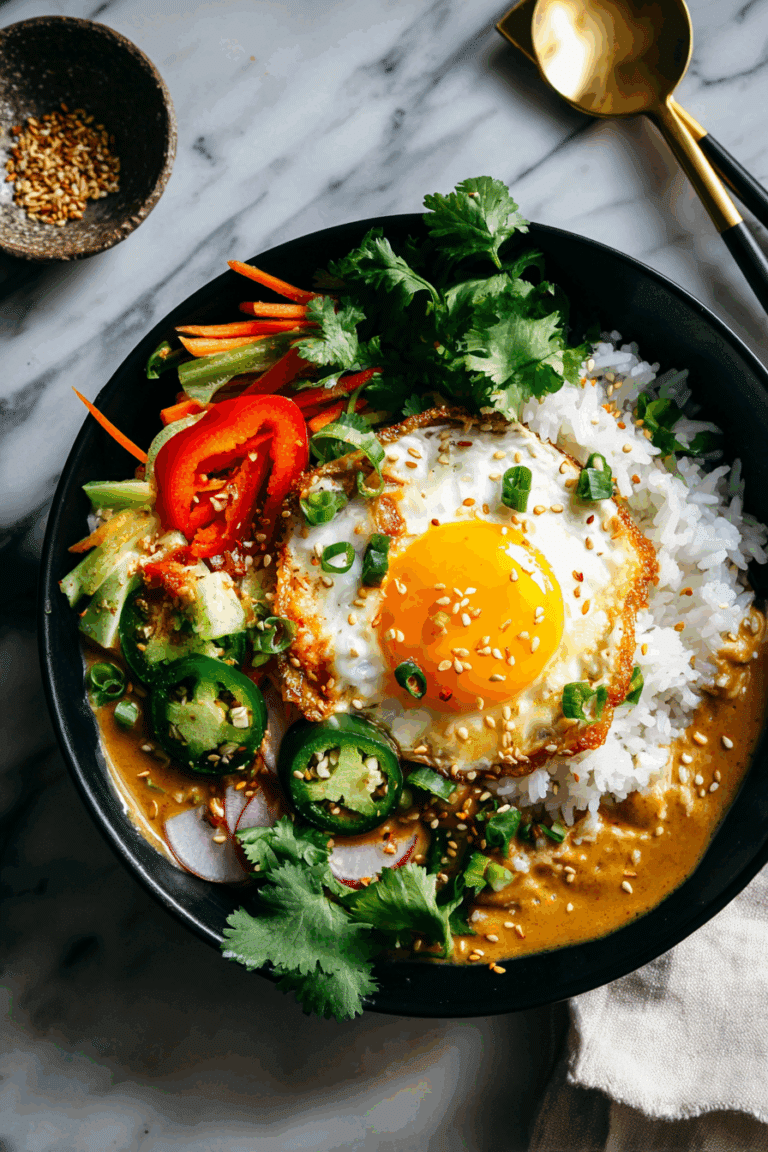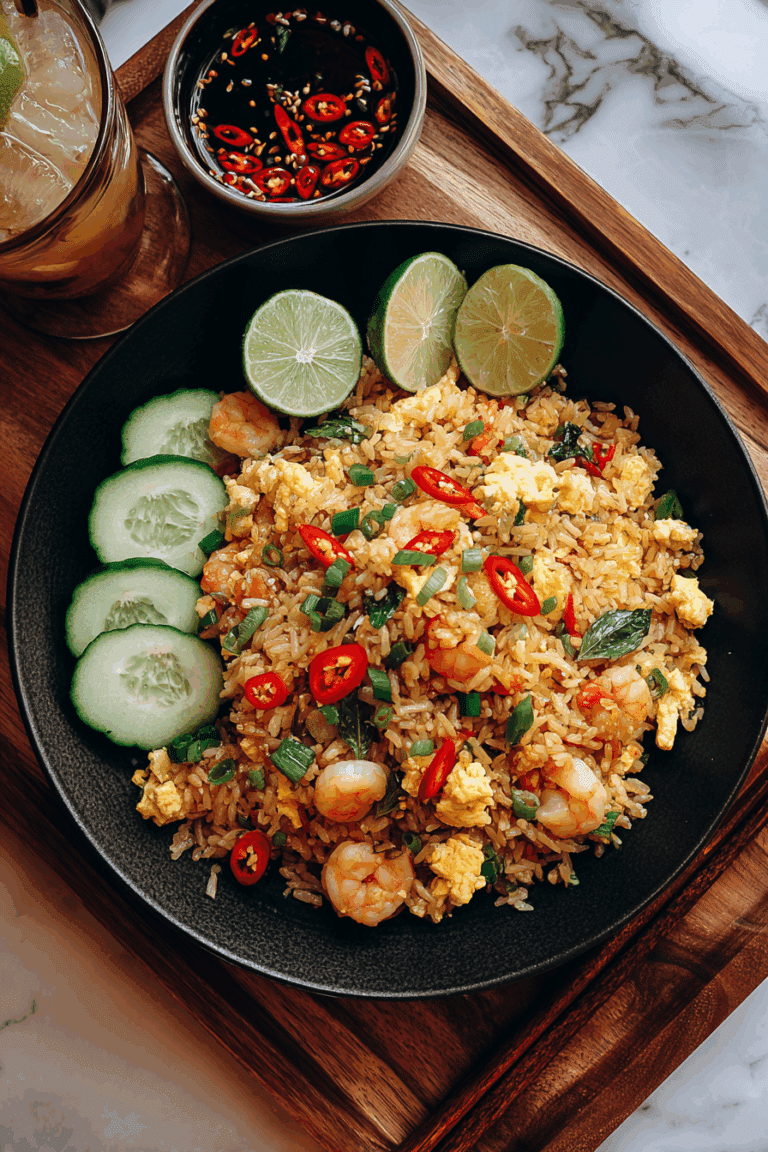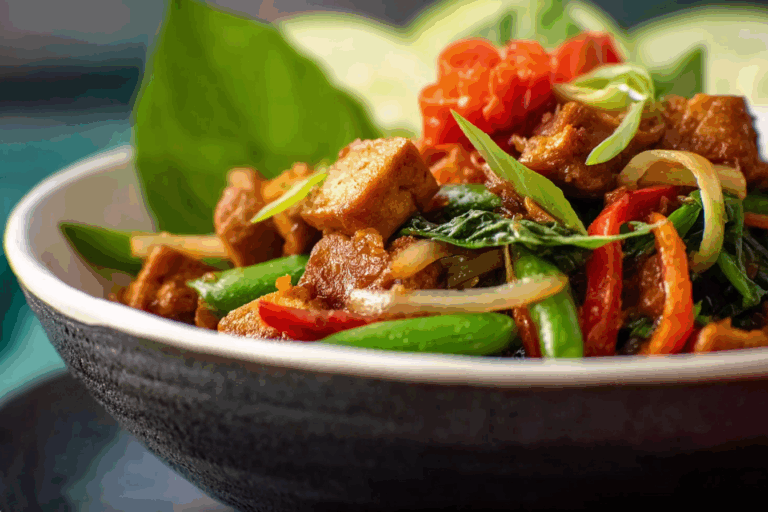Steamed Pandan Tapioca Cakes: A Tropical Treat You’ll Love
Steamed Pandan Tapioca Cakes are a traditional Southeast Asian dessert known for their soft, chewy texture and beautiful layered appearance. With alternating layers of rich brown sugar syrup and creamy coconut milk, these cakes are more than just a sweet treat they’re a story of heritage, texture, and taste.
At Just Thai Recipes, every recipe is rooted in personal history and cultural pride. As shared on the About page, Lina, the founder and passionate cook behind the brand, began her journey by recreating the comforting dishes of her childhood. One of the first desserts she made with her mother was a steamed tapioca cake. Her mom, known for her patience and precision, taught her the importance of detail from gently dissolving the brown sugar slabs to carefully alternating the layers to perfection.
Today, Lina shares this delicious recipe not just as a dish, but as a memory passed down from one generation to the next. This article will walk you through every step of making your own steamed pandan tapioca cakes at home, with in-depth instructions, tips, variations, and answers to common questions.
Whether you’re preparing it for a festive gathering, a quiet tea time treat, or simply want to explore Thai dessert traditions, you’ll find this guide comprehensive, easy to follow, and packed with flavor-enhancing techniques.
Table of Contents
Table of Contents
Understanding Steamed Pandan Tapioca Cakes
What Are Steamed Pandan Tapioca Cakes?
Steamed pandan tapioca cakes are a beloved Southeast Asian dessert often featured in Thai, Vietnamese, and Malaysian cuisine. These cakes are known for their alternating layers of light and dark, which symbolize harmony and balance in traditional Thai belief systems. The layers are made from two distinct batters—one rich in coconut milk and the other flavored with brown sugar and water—creating a visually appealing contrast and a dual-texture experience in every bite.
The signature chewy and bouncy texture comes from tapioca flour, a starchy powder derived from cassava root. Unlike Western cakes that rely on leavening agents like baking powder or eggs, steamed tapioca cakes gain their structure solely through the steaming process and the gelatinous nature of tapioca starch. This gives them a springy, slightly sticky texture that makes each bite satisfyingly dense yet smooth.
Many traditional versions include natural flavorings like pandan, which is made from the leaves of the screwpine plant and gives the cakes a fragrant, vanilla-like aroma and a soft green hue. These cakes can be served at room temperature or chilled for a firmer bite. When stored correctly, they hold their texture for days, making them a favorite make-ahead dessert.
The Cultural Roots Behind Steamed Pandan Tapioca Cakes
The origin of steamed tapioca cakes lies deep within the culinary traditions of Southeast Asia. In Thai culture, layered desserts such as these are not just appreciated for their taste but also for their symbolic meanings. The layers often represent progression, harmony, or unity—values that are highly celebrated in Thai family gatherings and religious offerings.
In many Thai households, steamed cakes are reserved for special occasions like New Year’s celebrations, weddings, or ancestral worship ceremonies. The pandan leaf, used for its aroma and color, is deeply tied to Thai and Indonesian culinary history. It is often associated with good fortune and is thought to bring calm and balance to the body.
Making these cakes was often a communal activity, especially during festivals. Mothers and daughters would gather in the kitchen to prepare ingredients, pour each layer with care, and pass on culinary traditions that have stood the test of time. Today, the act of making steamed pandan tapioca cakes continues to be a cherished ritual, tying together family, culture, and flavor.
Now that we understand their origin and significance, let’s explore the key ingredients that make these steamed tapioca cakes so flavorful and unique.
Print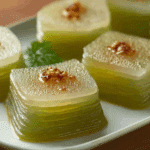
Steamed Pandan Tapioca Cakes
- Prep Time: 20 minutes
- Cook Time: 50 minutes
- Total Time: 1 hour 10 minutes
- Yield: 6–8 servings 1x
- Category: Dessert
- Method: Steaming
- Cuisine: Thai
- Diet: Vegetarian
Description
A traditional Thai dessert made with layers of chewy tapioca flour, sweet brown sugar syrup, and creamy coconut milk, often flavored with pandan for aroma and color. Steamed Pandan Tapioca Cakes are visually striking, naturally gluten-free, and perfect for any occasion.
Ingredients
- 185 g Chinese brown sugar slabs
- 300 ml water
- 120 g tapioca flour (for sugar layer)
- 200 ml full-fat coconut milk
- 125 ml milk (whole or plant-based)
- 80 g tapioca flour (for milk layer)
- Pandan extract (optional)
- Shredded coconut (for garnish)
- Toasted sesame seeds (for garnish)
- Peanuts, chopped (optional garnish)
Instructions
- Dissolve brown sugar in boiling water and let it cool for at least 5 minutes.
- In a bowl, mix cooled sugar water with 120 g tapioca flour until smooth to form the brown batter.
- In a separate bowl, mix coconut milk, milk, and 80 g tapioca flour until fully combined to form the milk batter. Add pandan extract if desired.
- Lightly oil a heatproof dish and bring water to a boil in a steamer.
- Pour a thin layer of brown batter into the dish and steam for 3–4 minutes until translucent.
- Pour a layer of milk batter and steam for another 3–4 minutes until set.
- Continue alternating layers, steaming each until fully set before adding the next.
- After the final layer, allow the cake to cool completely at room temperature.
- Once cooled, garnish with shredded coconut, sesame seeds, and optional peanuts.
- Slice with an oiled knife and serve at room temperature.
Notes
- Always stir each batter before pouring to prevent starch settling.
- Do not rush steaming. Each layer must set completely to avoid blending.
- For extra chewiness, let the cake sit overnight before slicing.
- Store at room temperature for 1 day or refrigerate up to 4 days.
- To restore softness after refrigeration, re-steam slices briefly.
Nutrition
- Serving Size: 1 slice (approx. 100g)
- Calories: 180
- Sugar: 14g
- Sodium: 35mg
- Fat: 5g
- Saturated Fat: 4g
- Unsaturated Fat: 1g
- Trans Fat: 0g
- Carbohydrates: 32g
- Fiber: 1g
- Protein: 1g
- Cholesterol: 0mg
Keywords: Steamed Pandan Tapioca Cakes, Thai dessert, pandan cake, coconut tapioca, steamed tapioca, traditional Thai recipe, gluten free dessert
Essential Ingredients for Steamed Pandan Tapioca Cakes
Key Components for Flavor, Texture, and Aroma
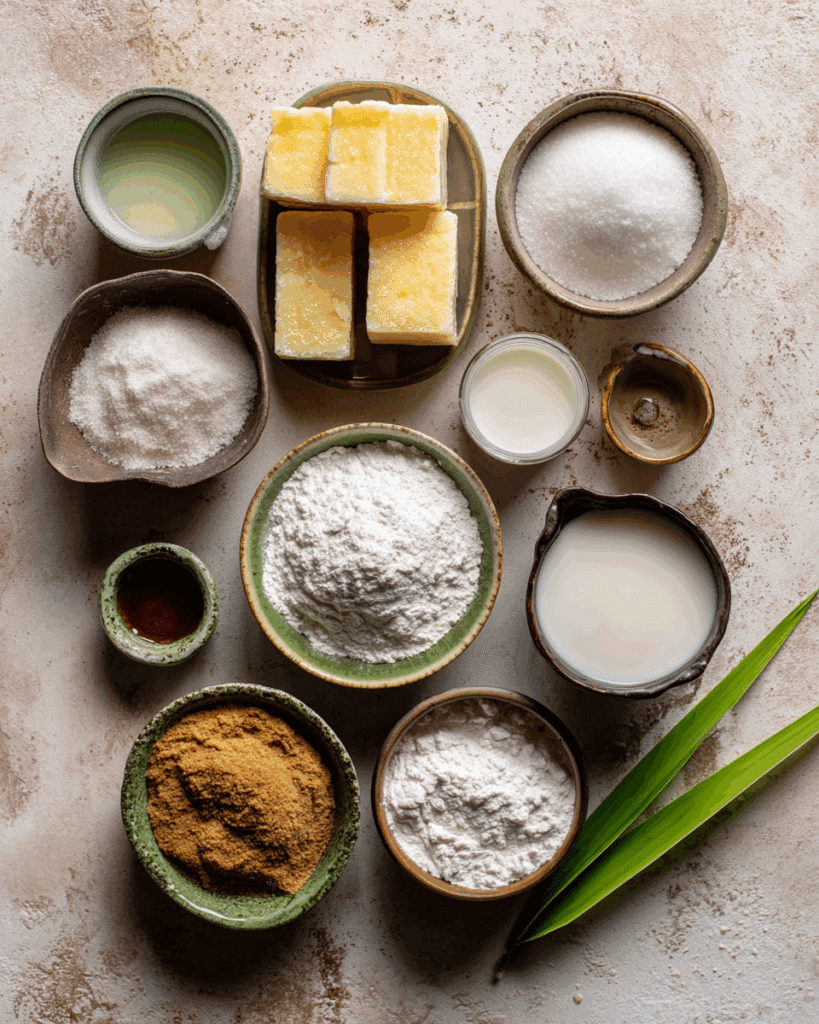
To create authentic and delicious Steamed Pandan Tapioca Cakes, choosing the right ingredients is essential. Each component plays a specific role in the final texture and taste, from the chewiness of the layers to the sweet aroma that fills your kitchen during steaming.
1. Tapioca Flour or Tapioca Starch
Tapioca flour, also known as tapioca starch, is the main ingredient. It comes from the cassava root and gives the cakes their signature chewy, bouncy texture. It’s important to use pure tapioca starch and not substitute it with corn or rice flour. The texture won’t be the same, and it’s this chewy bite that defines a great steamed tapioca cake.
2. Chinese Brown Sugar Slabs
This is what gives the brown layers their rich, caramel-like sweetness and a deeper flavor than regular granulated sugar. Brown sugar slabs, also known as peen tong or nám tan óoi, are traditional in Thai and Chinese cooking. If you can’t find these, you can substitute with light or dark brown sugar, but reduce the amount by 30% as it’s sweeter in its granulated form.
3. Coconut Milk
Use full-fat, unsweetened coconut milk for richness and creaminess in the white layers. Coconut milk not only provides a contrast in flavor but also balances the sweetness of the brown sugar. A good quality coconut milk has a thick, creamy consistency with a mild coconut fragrance.
Looking for more coconut-based dishes? Check out how coconut enhances flavor in savory recipes like Thai Coconut Rice.
4. Milk (Whole or Plant-Based)
To slightly lighten the coconut layer, milk is added. Whole milk works best for a smooth finish, but almond milk or oat milk are excellent plant-based alternatives. These options still maintain the richness while making the dessert dairy-free.
5. Pandan Essence or Extract
Pandan is optional but highly recommended. It adds a grassy-vanilla aroma and a beautiful green hue that makes the cake even more visually appealing. Use either natural pandan extract or a few drops of store-bought pandan essence if fresh leaves are unavailable.
6. Water
Used to dissolve the brown sugar and dilute batters. Make sure to cool the water before mixing it with tapioca flour to prevent clumping.
7. Toppings: Shredded Coconut, Sesame Seeds, Jujube, Peanuts
Toppings are optional but traditional. Shredded or dried coconut adds texture, toasted sesame seeds give a nutty flavor, and jujube slices or crushed peanuts add an earthy twist.
For another Thai dessert that uses similar ingredients and layering techniques, don’t miss our Sticky Rice Layer Cake. It also celebrates the delicate balance of sweet and chewy textures.
The Importance of Ingredient Quality Of Steamed Pandan Tapioca Cakes
When making steamed pandan tapioca cakes, ingredient quality directly affects the final outcome:
- Use thick, creamy coconut milk—avoid watered-down brands.
- Always dissolve brown sugar completely before mixing to avoid grit.
- Stir the batters just before pouring each layer to prevent the tapioca starch from settling.
Using quality ingredients ensures the layers remain distinct, the texture is elastic yet soft, and the flavor profile is deep and satisfying. Remember, desserts like these rely on simple ingredients done right.
Up next, we’ll walk through the step-by-step instructions to prepare both batters and how to layer them like a pro.
Step-by-Step Instructions for Making the Cake
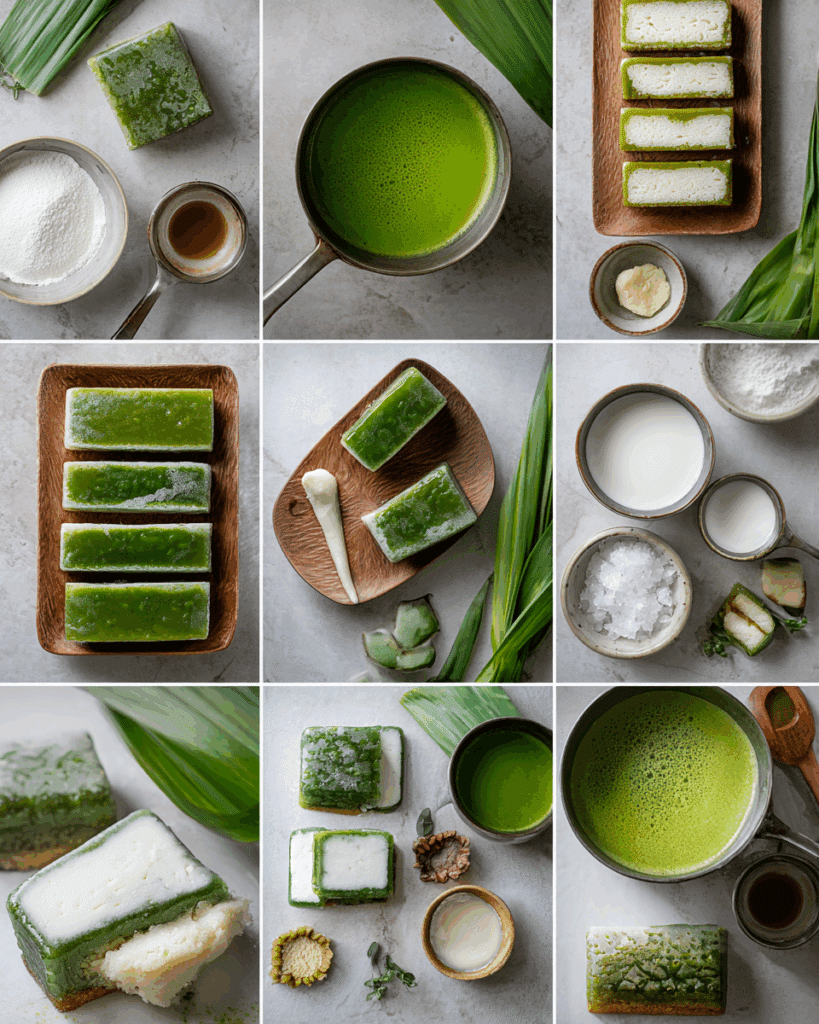
Preparing the Two Distinct Batters
Creating Steamed Pandan Tapioca Cakes involves preparing two separate batters—one rich in brown sugar syrup and the other creamy with coconut milk. Both batters rely on tapioca flour for their elasticity, but their flavors differ significantly, providing a beautiful contrast in both appearance and taste.
Sugar Water Batter (Brown Layer)
Ingredients:
- 185 g Chinese brown sugar slabs (or reduce quantity by 30% if using granulated)
- 300 ml water
- 120 g tapioca flour or starch
Steps:
- In a small pot, bring 300 ml of water to a boil.
- Add the brown sugar slabs and stir until completely dissolved.
- Remove from heat and allow the syrup to cool for at least 5 minutes.
- In a mixing bowl, add 120 g of tapioca starch.
- Slowly pour the cooled sugar water into the flour while stirring continuously. Mix well until smooth and free of lumps.
Tip: If your mixture begins to settle at the bottom, give it a gentle stir before each use during layering. This keeps the starch evenly distributed for a consistent layer.
Milk Batter (White Layer)
Ingredients:
- 200 ml full-fat unsweetened coconut milk
- 125 ml whole milk or plant-based alternative
- 80 g tapioca flour or starch
Steps:
- In a separate bowl, pour in the tapioca flour.
- Shake your can of coconut milk well, then add 200 ml into the bowl.
- Add 125 ml of milk (dairy or non-dairy).
- Stir everything thoroughly until the flour is dissolved and the batter is smooth.
Tip: For a green pandan twist, add a few drops of pandan extract to the milk batter. This creates a visually striking green-and-brown layered effect and infuses a distinct floral aroma.
For inspiration and visual examples of this dessert’s regional cousins, explore Toisan Steamed Tapioca Cake or Pandan and Coconut Tapioca Cake Recipe on Viet World Kitchen, both excellent references for variations.
Steaming and Layering the Cake
Once your batters are ready, it’s time to build the layers.
Tools You’ll Need:
- Heat-proof glass or stainless-steel steaming dish (6-inch diameter is ideal for a 1-inch tall cake)
- A steamer with a tight-fitting lid
- Brush for oiling the dish
- A ladle or measuring cup for pouring batters
Step-by-Step Process:
- Fill your steamer with water and bring to a boil. Ensure there is plenty of steam, but the water should not touch the base of your steaming dish.
- Lightly oil the inside of the dish with a neutral oil like coconut or canola oil.
- Stir the brown sugar batter, then pour just enough to cover the base of the dish (about 3 tablespoons). Steam over medium heat for 3–4 minutes until the layer is fully set and translucent.
- Stir the milk batter, then pour the same amount over the brown layer. Steam again for 3–4 minutes until opaque and solid.
- Continue alternating between the two batters until all batter is used. You should end with a brown layer.
- Watch for steaming cues: If layers wrinkle, reduce the heat. If bubbles appear, shorten the steaming time. If a layer remains milky, continue steaming until clear.
Final Garnishing
After the final layer is done, let the cake rest in the steamer with the lid off for 5 minutes, then remove it to cool fully.
Before serving, top with:
- Shredded or dried coconut
- Lightly toasted sesame seeds
- Optional: chopped jujube or crushed peanuts
The garnishes not only add texture but also a beautiful rustic appearance. For more on kueh-style desserts that use similar garnishing and steaming methods, check out this guide to Kueh Ubi Kayu (Steamed Cassava Cake) or the Pandan Tapioca Kueh recipe on Eat What Tonight.
Now that you know how to prepare and layer the cake, the next section will show you how to achieve a perfect texture and avoid common steaming mistakes.
Steaming and Layering Tips for Perfect Texture
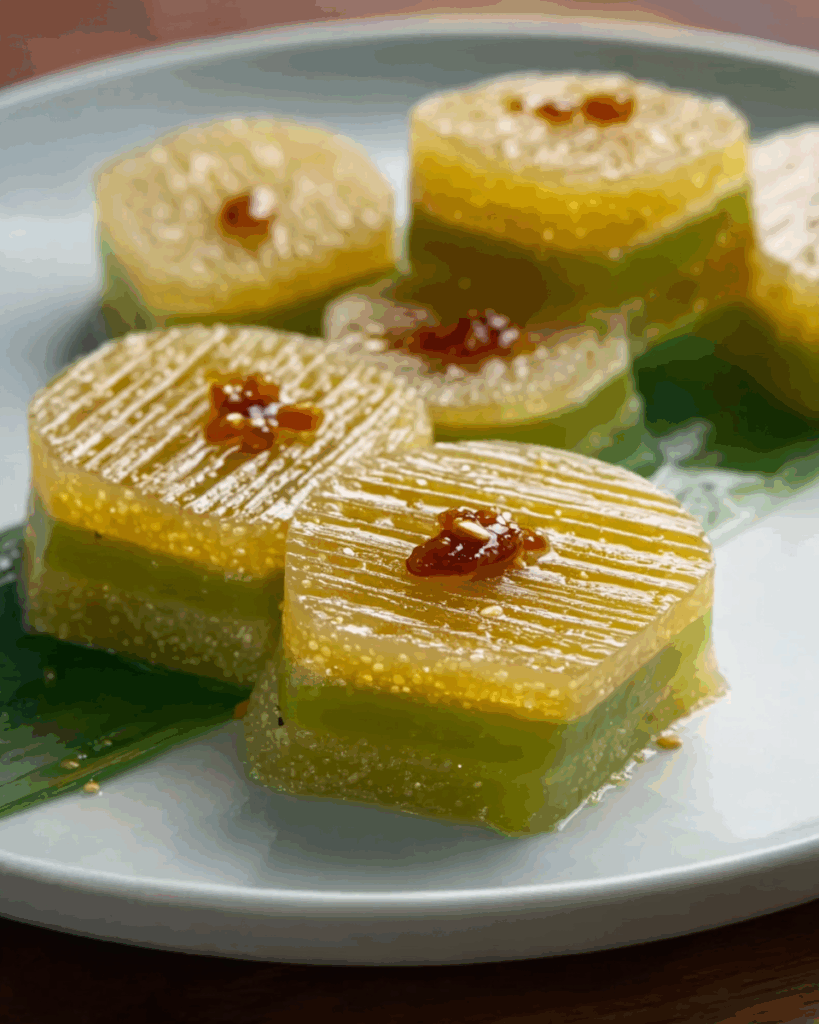
How to Achieve a Smooth, Chewy Consistency
Steaming is the most crucial part of making Steamed Pandan Tapioca Cakes. The structure, color separation, and chewiness of the layers all depend on how well you manage the heat, moisture, and timing during this stage. Unlike baking, which uses dry heat, steaming surrounds the cake with moist heat, which reacts with tapioca starch to produce its signature elasticity.
To create a uniform and chewy consistency, it’s essential that each layer is steamed just long enough to set without overcooking or undercooking. If the timing is off, the layers may appear wrinkled, cloudy, or stuck together. Each batter has a slightly different consistency, so it’s important to stir thoroughly before pouring each time.
Before steaming begins, ensure your steamer has reached a strong boil so there’s sufficient steam pressure. A common mistake is starting the steaming process before the water is fully boiling, which can lead to inconsistent layer formation.
Temperature Control and Timing
Maintaining a steady temperature throughout the steaming process is vital. Too much heat and the layers will wrinkle or bubble. Too little heat and the layers won’t set properly, causing them to blend instead of stack neatly.
Here are some essential tips for temperature and timing:
- Always steam over medium heat. High heat will cause bubbles or overcooked layers, while low heat may make the layers take too long to set and risk blending.
- Each layer should take about three to four minutes to set. However, the last few layers may require an additional one to two minutes due to the accumulated heat inside the dish.
- Do not open the lid too frequently, as this causes temperature drops. Only open the lid when absolutely necessary to pour the next layer.
Use a transparent glass dish if possible so you can observe the layers as they steam. You’ll be able to tell a layer is ready when it appears either completely translucent or opaque, depending on the batter used.
Preventing Common Steaming Errors
Understanding what causes certain visual or textural problems will help you avoid them. Here’s a breakdown of common issues and how to prevent them:
Wrinkled Layers
If your steamed layers appear wrinkled, this is usually a result of steam that is too intense. Reduce the heat slightly and allow the layer to set gently before adding the next one.
Bubbles or Craters
This occurs when a layer is over-steamed or the steamer’s lid is not tight-fitting. Try shortening the steaming time and ensuring the steamer is sealed properly to maintain even moisture.
Sticky Layers That Merge Together
If layers do not set properly before the next is added, they will merge, losing the defined look of the cake. Always wait until the surface looks fully set before pouring the next batter layer.
Hard or Rubbery Texture
If the cake feels too tough or rubbery when cooled, the steaming time might have been too long. Each layer only needs to set, not overcook.
Layer Separation During Cooling
Sometimes, layers may separate slightly once cooled. This usually happens when the batter is not stirred well enough before pouring. Always stir the batter again just before ladling it into the steaming dish to keep the tapioca starch evenly suspended.
These practical techniques make all the difference between a dense, rubbery block and a soft, layered, beautifully chewy dessert that melts in your mouth. Mastering the steaming process ensures that each bite has a smooth finish, distinct layers, and a perfect balance of springiness and softness.
Finishing Touches and Presentation
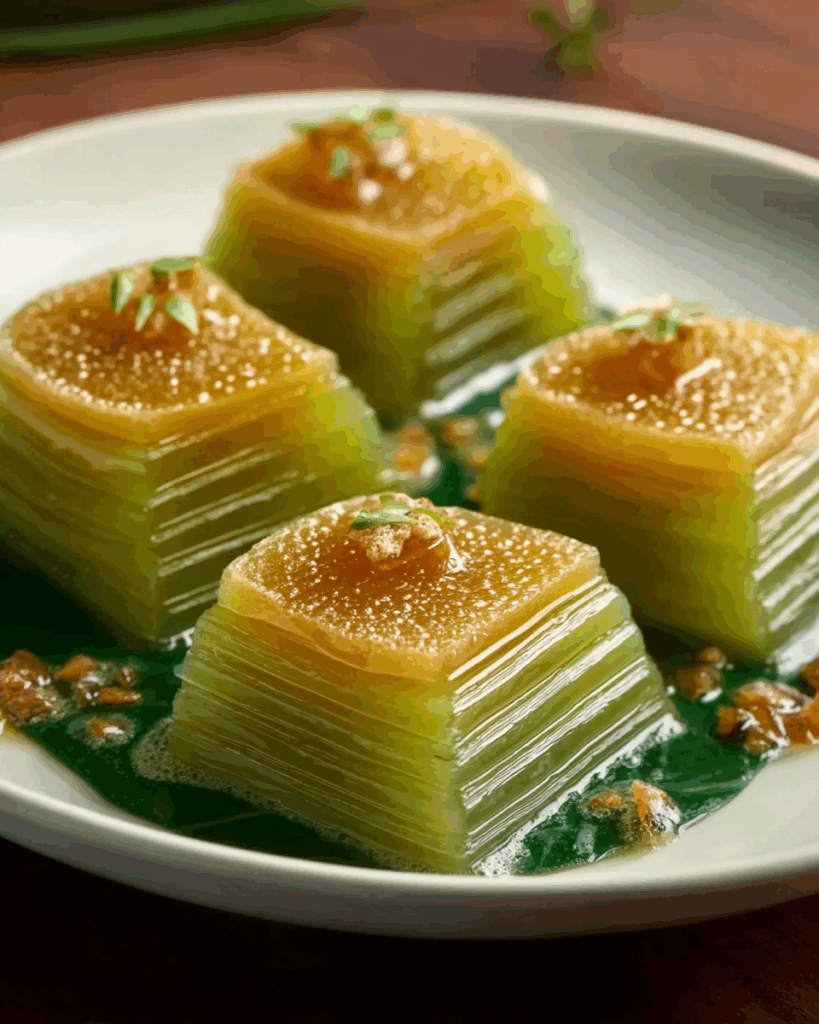
Proper Cooling for the Best Texture
Once you’ve completed steaming all the layers of your pandan tapioca cake, resist the urge to remove it too soon. Letting the cake cool properly is crucial. This resting period allows the layers to set fully and firm up, making it easier to cut cleanly without tearing or pulling.
Cooling should be done at room temperature, not in the refrigerator immediately. Rapid cooling can cause the layers to contract unevenly and potentially separate. Leave the cake uncovered on the counter for at least two hours or until it is no longer warm to the touch. Some prefer to let it rest overnight, which often improves the cake’s chewiness.
If you’re planning to refrigerate it, only do so after the cake has completely cooled to avoid condensation forming on the surface. This could affect texture and make the top layer slightly sticky.
How to Slice the Cake Cleanly
The way you cut steamed tapioca cakes can make a big difference in presentation. A jagged or sticky cut can pull apart the layers or leave ragged edges, which can ruin the clean look of this dessert.
Here are a few simple techniques to achieve smooth, neat slices:
- Use a sharp cleaver or chef’s knife. Dull knives tend to drag through the chewy texture, tearing the layers.
- Lightly oil the blade before slicing. This prevents the sticky starch from clinging to the knife.
- For best results, press down with one clean motion instead of sawing back and forth.
- Kitchen scissors can be used to trim smaller servings, especially if you’re packing the cake for gifting or portioning for kids.
If your goal is to showcase the colorful layers, slice the cake into rectangles or diamonds. Uniform cuts not only make the dessert more attractive but also provide consistent texture in every piece.
How to Add Toppings for Texture and Appeal
Toppings are optional, but they elevate the flavor and texture of steamed pandan tapioca cakes. You can use ingredients like:
- Shredded coconut, either fresh or lightly toasted
- Toasted sesame seeds for nutty crunch
- Sliced jujube or dried red dates for sweetness and chewiness
- Crushed peanuts for added depth
Sprinkle these over the cake just before serving. If you’re making this dessert ahead of time, wait until serving day to add the toppings to prevent them from softening or absorbing moisture.
The contrasting textures and colors of these toppings not only enhance taste but also make the cake more visually inviting. A rustic finish with toasted sesame seeds and coconut shreds adds a homemade charm that suits casual family meals or festive occasions alike.
Storage Tips to Keep the Cake Fresh
Steamed tapioca cakes are best enjoyed at room temperature. However, proper storage will keep them tasting fresh for several days.
For short-term storage:
- Cover the dish with a food-safe wrap or transfer the cake to an airtight container.
- Store at room temperature for up to one day.
For longer storage:
- Refrigerate the cake in a sealed container.
- Expect the texture to firm up slightly in the fridge, but it will remain enjoyable.
- To soften before serving, simply re-steam the slices for a few minutes or allow them to come back to room temperature naturally.
Avoid freezing, as this may alter the texture of the tapioca starch and result in a grainy, icy finish after thawing.
With these final touches, you’ll serve a beautifully layered, perfectly sliced dessert that looks as good as it tastes. The effort you’ve put into preparing and steaming each layer will be clear the moment you present it.
Variations You Can Try
Steamed Pandan Layer Cake
One of the most visually striking adaptations of this dessert is the steamed pandan layer cake. While the original version alternates between brown sugar and milk layers, this variation replaces the brown sugar layer with pandan-flavored tapioca batter. The result is a vibrant green-and-white combination that not only looks stunning but also carries a fragrant floral aroma thanks to the pandan.
To make this version, simply divide your milk batter into two portions. Leave one plain and add pandan extract or juice to the other until it turns a light jade green. Alternate these two batters in your steaming dish, following the same layering and steaming process used in the original recipe.
The pandan version is especially popular during festivals, birthdays, and other celebrations. The color green is associated with renewal and luck in many Southeast Asian cultures, making this variation both a culinary and symbolic delight.
Coconut-Only Tapioca Cake
For those who prefer a more subtle sweetness or are looking for a simpler recipe, the coconut-only tapioca cake is a great choice. This version skips the brown sugar layer entirely and focuses solely on the creamy richness of coconut milk.
To make it, double the milk batter recipe and omit the brown sugar syrup altogether. You’ll end up with a pure white cake that has a smooth texture and mild coconut flavor. While it lacks the color contrast of the layered versions, it makes up for it with a delicate, elegant appearance and a clean taste profile that pairs well with fresh fruits or tea.
This is also a great option for those who are limiting their sugar intake, as the natural sweetness of coconut milk often suffices without the need for additional sweeteners.
Vegan and Dairy-Free Adaptations
Although the traditional recipe uses whole milk along with coconut milk, it’s very easy to make the dish completely dairy-free or vegan. Simply substitute the milk with a plant-based alternative like almond milk, soy milk, or oat milk.
These alternatives maintain the creamy consistency needed for the batter while aligning with dietary preferences. Almond milk adds a slightly nutty note, while oat milk offers a natural sweetness and smooth finish.
You can also use maple syrup or coconut sugar as a substitute for brown sugar if you want to use a less refined sweetener. Keep in mind that these may alter the color and flavor of the final product slightly, but the essential texture will remain intact.
Infused Flavors and Natural Dyes
To experiment with even more flavor combinations, consider adding other natural ingredients to your batters. Here are a few ideas:
- Butterfly pea flower for a deep blue hue
- Mango puree for a golden yellow color and fruity flavor
- Ube (purple yam) extract for a rich purple tint
- Durian pulp for a bold Southeast Asian twist
These additions can be used to replace or complement one of the existing batters, resulting in cakes that are not just visually appealing but also layered with complex flavors. When incorporating new ingredients, remember to maintain the consistency of the batter so it still sets properly during steaming.
These creative twists allow you to bring personality and regional flair into a time-honored dessert. Whether you’re going for color, flavor, or dietary alignment, steamed pandan tapioca cakes offer a flexible canvas that encourages experimentation.
Troubleshooting Common Mistakes
Why Your Steamed Pandan Tapioca Cakes Might Not Set Properly
One of the most common issues when making Steamed Pandan Tapioca Cakes is that the layers don’t set as expected. This typically happens when the batter is poured before the previous layer is fully steamed. If a layer is still semi-liquid, the next one blends into it instead of sitting cleanly on top, causing the signature stripes to disappear.
To prevent this, always make sure the surface of each layer is solid before pouring the next. A good sign is a slightly bouncy surface that no longer appears milky or runny. Each layer generally takes three to four minutes to steam fully, though later layers may need slightly more time due to increased steam buildup.
Another common reason the layers don’t set properly is the incorrect ratio of flour to liquid. If the batter is too runny or too thick, it won’t behave correctly during the steaming process. Stick to precise measurements and stir thoroughly to ensure consistency across all layers.
What Causes Wrinkling on the Top Layer?
If the top layer of your Steamed Pandan Tapioca Cakes appears wrinkled, it is usually due to excessive steam or high heat. Wrinkles can form when steam condenses and drips back onto the cake during the final moments of steaming.
To avoid this, wrap the lid of your steamer with a clean kitchen towel to absorb excess moisture. Also, lower the heat slightly for the final layer and steam it more gently. This helps prevent steam from aggressively hitting the surface, which can lead to textural problems.
Allow the final layer to rest uncovered in the steamer for a minute or two before removing. This helps the top layer firm up without additional moisture falling onto it.
Why Are There Bubbles in My Layers?
Bubbles can form when batter is over-mixed or when steam is too strong. Stirring the batter too vigorously introduces air that stays trapped during steaming, leading to unsightly holes and uneven texture.
Instead, gently stir the batter just enough to combine ingredients and re-stir briefly before pouring each layer. Keeping the heat at a moderate level throughout the process also ensures the layers cook evenly without creating bubbles.
If you notice bubbles forming during steaming, reduce the heat slightly on your next layer and consider skimming off any foam from the surface of the batter before pouring.
What to Do if the Layers Stick to the Pan
If your Steamed Pandan Tapioca Cakes stick to the steaming dish, it likely wasn’t greased properly before use. Always brush a thin layer of neutral oil on the bottom and sides of your dish before pouring the first layer of batter. This creates a nonstick surface and makes it much easier to remove the cake once it has cooled.
Another method is to line the base of your steaming dish with parchment paper cut to fit. This guarantees clean removal, especially for first-time makers concerned about sticking.
When unmolding the cake, use a lightly oiled spatula or butter knife to gently run along the edge of the pan. This helps separate the cake from the sides before inverting or slicing.
Fixing Overcooked or Rubbery Texture
If your Steamed Pandan Tapioca Cakes turn out rubbery or overly firm, it’s often due to oversteaming or incorrect ingredient ratios. Overcooking drives out too much moisture, making the layers tough instead of pleasantly chewy.
To fix the texture after cooking, you can re-steam individual slices briefly while covered with a damp cloth. This adds back some moisture and softens the cake slightly.
Next time, reduce the steaming time slightly and ensure your batter has the correct balance between tapioca flour and liquid. Always measure carefully and avoid doubling recipes without recalculating steaming times.
Salvaging Cakes with Blended Layers
If your layers have accidentally merged and lost their visual definition, don’t worry. The cake is still edible and will likely taste just as good. You can repurpose it by cutting it into small squares and rolling them in shredded coconut. This makes for a rustic presentation that hides the blending while still honoring the traditional flavor.
Alternatively, serve the imperfect cake warm with a drizzle of coconut cream or a scoop of tropical fruit. The texture remains satisfying, and the visual setback can be turned into an intentional style.
By identifying these common issues and learning how to correct them, you’ll build confidence in making Steamed Pandan Tapioca Cakes. Practice improves precision, and with each attempt, your skills will improve along with your results.
Serving Suggestions and Presentation Tips
How to Serve Steamed Pandan Tapioca Cake the Traditional Way
Serving Steamed Pandan Tapioca Cake properly adds the final touch to all the effort you’ve put into crafting each layer. Traditionally, this cake is served at room temperature. Once cooled, the texture becomes chewy yet soft, making it incredibly satisfying to bite into.
Cut the cake into uniform rectangles, squares, or diamonds. A clean, symmetrical cut highlights the layers and reveals the beautiful alternating colors. If you’ve used pandan extract, the contrast between the green and white or green and brown layers will be especially eye-catching.
For a more authentic Thai presentation, place each piece on a small banana leaf or ceramic dessert plate. Add a sprinkle of toasted sesame seeds or shredded coconut on top for both garnish and texture.
Whether you’re hosting a dinner party or preparing snacks for the family, a well-presented Steamed Pandan Tapioca Cake can stand on its own as the centerpiece of your dessert table.
Best Times to Enjoy Steamed Pandan Tapioca Cake
While this dessert is delicious at any time of day, it’s especially popular during late afternoon tea, family gatherings, or after a spicy main course. Its cool, creamy texture and mildly sweet flavor make it a soothing finish to rich or spicy dishes.
Many people also enjoy Steamed Pandan Tapioca Cake as a mid-morning snack or part of a traditional Thai breakfast platter. Its filling texture and low fat content make it a light yet satisfying option, even when eaten on its own.
The beauty of Steamed Pandan Tapioca Cake lies in its versatility. It can be eaten warm right after steaming for a softer feel or chilled overnight for a firmer, more chewy experience. Both textures are equally appealing and often come down to personal preference.
Pairing Ideas for Drinks and Other Dishes
To elevate the dessert experience, consider pairing your Steamed Pandan Tapioca Cake with complementary drinks or side dishes. Traditional Thai or Southeast Asian beverages work best to complement the subtle flavors of the cake.
Here are a few great pairing ideas:
- Thai iced tea for a creamy, spiced contrast
- Lemongrass or pandan herbal tea for a gentle aromatic pairing
- Fresh coconut water for a refreshing, tropical match
- Light jasmine tea to keep the flavor profile clean and floral
If you’re creating a full meal experience, Steamed Pandan Tapioca Cake pairs well with grilled or stir-fried dishes as a refreshing follow-up. Because the dessert is not overly sweet, it balances out stronger flavors and offers a cooling sensation.
Plating Techniques to Impress Your Guests
Plating is about more than just aesthetics—it adds emotion to the dish. When serving Steamed Pandan Tapioca Cake, a few thoughtful presentation techniques can take your dish to the next level.
- Use small dessert forks or bamboo picks for individual servings
- Dust the top lightly with fine coconut flakes or a touch of powdered sugar
- Arrange the cake pieces in a fan or flower pattern on the plate
- Serve alongside fresh tropical fruits like mango, lychee, or dragon fruit for a colorful, refreshing combo
For special occasions, you can layer thin slices of Steamed Pandan Tapioca Cake with other Thai sweets on a dessert tray. This creates a multi-textured platter that’s both festive and exciting for guests to explore.
Enhancing Texture with Complementary Elements
While Steamed Pandan Tapioca Cake has a naturally soft and bouncy texture, adding crisp or creamy components can elevate the experience. Consider offering small bowls of toasted coconut, roasted peanuts, or even a light coconut cream drizzle on the side.
These extras add variety to the mouthfeel, enhancing each bite and making the dessert more interactive. You can also offer a chilled version alongside a warm one, allowing your guests to experience how temperature affects the cake’s texture.
With thoughtful serving and presentation, Steamed Pandan Tapioca Cake becomes more than just a traditional treat. It becomes a complete sensory experience that appeals to the eyes, palate, and even memory, especially for those familiar with its nostalgic charm.
Serving Suggestions and Presentation Tips
When and How to Serve Steamed Pandan Tapioca Cakes
Steamed Pandan Tapioca Cakes are incredibly versatile and can be served on a variety of occasions. Their soft, chewy layers make them suitable for everything from casual afternoon snacks to elegant dessert platters at special celebrations. These cakes are typically enjoyed at room temperature, which allows their full flavor and texture to come through.
If you’re serving Steamed Pandan Tapioca Cakes at a family gathering, cut them into bite-sized squares or diamonds. This not only makes them easy to share but also showcases their beautiful layers. When presenting them on a tray or dessert board, arrange them in alternating patterns to emphasize the layered effect.
For more formal occasions, consider shaping the cake with small round or square molds after cooling. The structured appearance can elevate its visual appeal and make it a fitting addition to wedding dessert tables, holiday spreads, or cultural celebrations.
Best Times to Enjoy This Dessert
Steamed Pandan Tapioca Cakes are commonly eaten during festivals and traditional ceremonies, but they are equally loved as an everyday treat. Many enjoy them with a cup of hot tea or light herbal infusion in the afternoon. Because of their mild sweetness and satisfying texture, they make a great alternative to baked desserts that can often feel too heavy.
You can also serve Steamed Pandan Tapioca Cakes at breakfast as a sweet companion to coffee or alongside savory Thai dishes to balance flavors in a full meal. Their neutral sweetness and coconut undertones pair beautifully with bold, spicy dishes, making them an excellent palate cleanser.
Whether served on a quiet weekday or a festive weekend, Steamed Pandan Tapioca Cakes provide comfort and delight with every bite.
Ideal Pairings for Enhanced Flavor
Pairing the right beverage or side with your Steamed Pandan Tapioca Cakes enhances their taste and creates a memorable experience. Here are some popular pairings:
- Thai hot tea or green tea: The gentle bitterness of tea cuts through the richness of coconut and brown sugar.
- Fresh mango or papaya slices: The fruity brightness offers a refreshing contrast to the dense texture.
- Light coconut cream drizzle: For a more indulgent twist, serve the cakes with a thin drizzle of lightly sweetened coconut cream.
- Toasted peanuts or sesame seeds on the side: Adding a small bowl of these crunchy toppings lets guests customize their bites.
These pairings complement the soft, chewy texture of Steamed Pandan Tapioca Cakes while adding depth to each mouthful.
Presentation Tips for Maximum Appeal
Because Steamed Pandan Tapioca Cakes are layered, their visual impact lies in the neatness and uniformity of each slice. Here’s how to enhance the visual presentation:
- Cut with precision: Use an oiled knife to ensure clean edges that show off the contrast between layers.
- Use small cake liners: Present individual portions in mini cupcake liners for ease of serving and cleanliness.
- Garnish with intention: A light sprinkle of toasted coconut or black sesame seeds adds texture and beauty without overpowering the cake.
- Use a wooden or ceramic platter: Natural textures make the vibrant green and brown layers stand out.
If you’re packaging the cake as a gift, wrap individual slices in parchment or wax paper and secure with a piece of raffia or string for a handmade touch. It’s a thoughtful way to share the rich tradition of Steamed Pandan Tapioca Cakes with others.
These cakes are more than just sweets—they represent heritage, patience, and the joy of homemade cooking. With the right presentation and pairings, you can turn each serving of Steamed Pandan Tapioca Cakes into a heartfelt offering.
Conclusion
Steamed Pandan Tapioca Cakes are more than just a sweet treat—they are a reflection of heritage, patience, and culinary artistry. Their iconic chewy texture, aromatic pandan flavor, and distinct layered appearance make them a standout among traditional Southeast Asian desserts. Whether you grew up eating them during family celebrations or are discovering them for the first time, these cakes carry a warmth that invites both nostalgia and curiosity.
Throughout this guide, you’ve learned how to make Steamed Pandan Tapioca Cakes from scratch, starting with the careful preparation of two separate batters. You’ve seen how ingredients like tapioca flour, coconut milk, and brown sugar come together to form layers that are not only visually stunning but also rich in flavor and texture. You now understand the importance of proper steaming techniques and the timing required to create those clean, beautiful layers.
Serving and presentation are just as important. From casual tea snacks to festive centerpieces, Steamed Pandan Tapioca Cakes adapt beautifully to different settings. You’ve discovered how to elevate them with garnishes like toasted sesame seeds and shredded coconut, and how to pair them with complementary beverages and sides for a more complete experience.
You’ve also explored variations—like pandan-only versions, vegan adaptations, and colorful twists using natural ingredients. Each offers a new take on the classic, yet every version stays true to what makes Steamed Pandan Tapioca Cakes so unique: the comforting chew, the layered design, and the delicate sweetness that lingers.
We’ve answered the most common questions about Steamed Pandan Tapioca Cakes, from storage tips to how to fix texture issues. Troubleshooting becomes easier once you understand the role each ingredient and step plays in the final result. Every mistake is simply a chance to get better, and each successful batch is a reason to celebrate.
In a world full of fast food and shortcuts, making Steamed Pandan Tapioca Cakes invites you to slow down and connect with something timeless. Whether you follow the traditional recipe or make it your own, this dessert is about more than food—it’s about creating, sharing, and savoring each bite.
Now that you’re equipped with everything from start to finish, there’s no better time to get into the kitchen and make your own Steamed Pandan Tapioca Cakes. Every layer you pour is a layer of tradition, flavor, and love.
The next time someone asks you about your favorite Thai dessert, let your answer be simple and proud: Steamed Pandan Tapioca Cakes.
FAQs About Steamed Pandan Tapioca Cakes
Are Steamed Pandan Tapioca Cakes supposed to be chewy?
Yes, chewiness is one of the defining characteristics of Steamed Pandan Tapioca Cakes. This texture comes from the tapioca flour, which gels and firms up during steaming. Unlike baked cakes that are light and fluffy, this dessert has a dense, springy bite that holds its shape when sliced.
If your Steamed Pandan Tapioca Cakes turn out too soft or crumbly, it could be due to an incorrect ratio of flour to liquid or under-steaming. Follow the recommended measurements closely and ensure each layer is fully cooked before moving on. If the cakes feel rubbery, try reducing the steaming time slightly or using a softer plant-based milk to mellow the texture.
With these answers in hand, you’ll be better equipped to troubleshoot and refine your process. Making Steamed Pandan Tapioca Cakes is both a skill and an art, and each attempt brings you closer to mastering this delightful dessert.
Why do my Steamed Pandan Tapioca Cakes have uneven layers?
Uneven layers in Steamed Pandan Tapioca Cakes often result from two common mistakes: not stirring the batter before pouring and not waiting long enough for each layer to set. Tapioca flour tends to settle quickly, so always stir the batter again right before you ladle it into the pan. This ensures even distribution of starch and prevents thin or runny layers.
You also need to be patient while steaming each layer. Rushing the process and adding a new layer before the previous one is fully set can cause the layers to merge or become slanted. A consistent steaming temperature and precise timing will help produce clean, even stripes throughout the cake.
Can I substitute the milk in Steamed Pandan Tapioca Cakes with a plant-based option?
Absolutely. Steamed Pandan Tapioca Cakes are flexible and easy to adapt for dietary needs. You can substitute whole milk with almond milk, oat milk, or soy milk without affecting the structure of the cake. Each plant-based milk will contribute its own subtle flavor, but the essential texture will remain chewy and soft.
In fact, some cooks prefer using all coconut milk for a richer version. Just be sure to maintain the correct liquid-to-flour ratio when making substitutions. If using lighter plant milks, choose unsweetened varieties to control the sweetness of your Steamed Pandan Tapioca Cakes.
Can I make Steamed Pandan Tapioca Cakes without pandan extract?
Yes, you can make Steamed Pandan Tapioca Cakes without pandan extract. The pandan flavor is traditional but not essential to the structure or base recipe. If pandan is not available, simply leave it out. The cake will still have its signature chewy texture and delicious coconut and brown sugar flavor.
However, if you’re looking for an aromatic and colorful touch, pandan extract adds both a subtle vanilla-like fragrance and a natural green hue. If desired, other flavorings such as vanilla, mango, or ube extract can also be used to experiment with different tastes and colors in your Steamed Pandan Tapioca Cakes.
How do you store Steamed Pandan Tapioca Cakes to keep them fresh?
Storing Steamed Pandan Tapioca Cakes correctly helps maintain their chewy texture and flavor. After steaming, allow the cake to cool completely at room temperature. Once cooled, transfer it into an airtight container. If you plan to eat the cake within one day, it can stay at room temperature in a covered dish. For longer storage, refrigerate the cake for up to four days.
Keep in mind that Steamed Pandan Tapioca Cakes may become slightly firmer after refrigeration. This is normal due to the tapioca starch. To restore the original texture, re-steam the slices briefly or let them return to room temperature before serving. Avoid freezing, as it can negatively affect the texture.
Why do the layers of my Steamed Pandan Tapioca Cakes stick to the pan?
If your Steamed Pandan Tapioca Cakes stick to the pan, it’s likely because the pan wasn’t greased well before the first layer was poured. Always use a light coat of neutral oil on the base and sides of your steaming dish. This small step helps with easy release once the cake is fully cooled.
Also, let the cake cool completely before trying to remove it. Warm tapioca layers are more fragile and tend to stick more. Once cooled, use a lightly oiled knife or spatula to gently loosen the edges before lifting out the cake. A properly greased and cooled cake should come out in one smooth motion.

